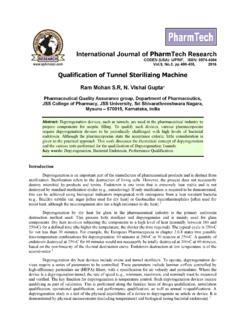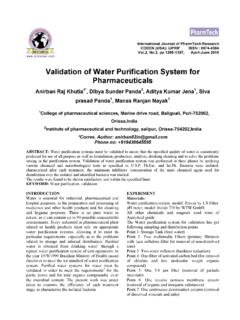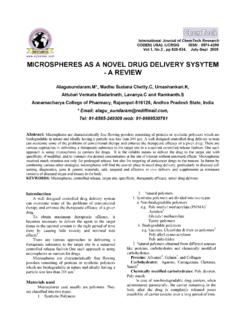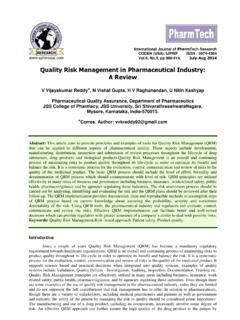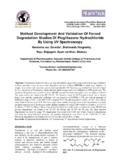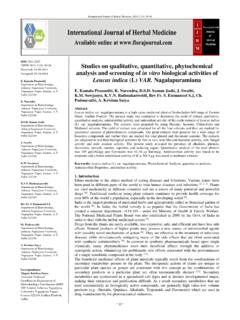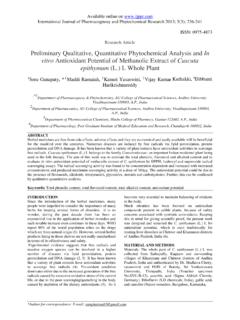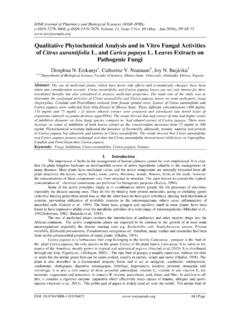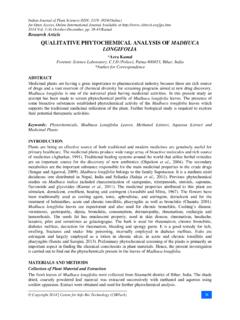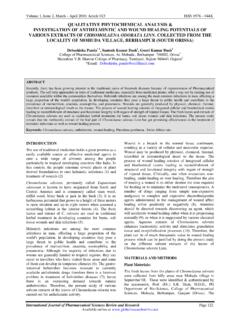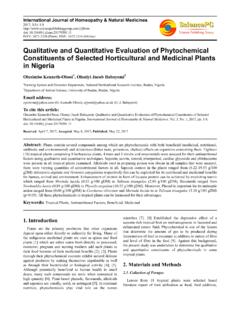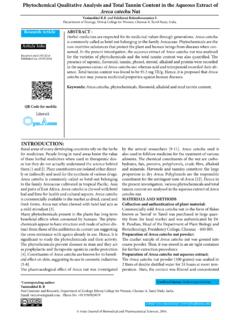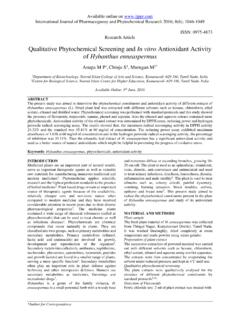Transcription of Phytochemical Screening, Quantitative Analysis of Primary ...
1 International Journal of PharmTech Research CODEN (USA): IJPRIF ISSN : 0974-4304 , , pp 521-529, April-June 2014 Phytochemical screening , Quantitative Analysis of Primary and Secondary Metabolites of Cymbopogan citratus (DC) stapf. leaves from Kodaikanal hills, Tamilnadu and * Department of Biotechnology, Mother Teresa Women s University, Kodaikanal- 624 101, Tamilnadu, India *Corres. author: Contact No: 08012461292 Abstract: The study includes Phytochemical screening and quantification of Primary and secondary metabolites like chlorophyll, carbohydrates, protein, lipids, phenol, tannin and flavonoids from Cymbopogan citratus (DC) Stapf.
2 Leaves. Keywords : Phytochemical screening , Primary and Secondary metabolites, Cymbopogan citrates. Introduction: Since ancient times, people have been exploring the nature particularly medicinal plants in search of new drugs. Medicinal plants are used by 80% of the world population for their basic health needs. India is the birth place of renewed system of indigenous medicines such as Siddha, Ayurveda and Unani. Traditional systems of medicines are prepared from a single plant or combinations of more than one plant. These efficacy depends upon the current knowledge about taxonomic features of plant species, plant parts and biological property of medicinal plants which in turn depends upon the occurrence of Primary and secondary metabolites 1. Plant synthesize a wide range of chemical compounds which are classified based on their chemical class, biosynthetic origin and functional groups into Primary and secondary metabolites.
3 Primary metabolites directly involved in growth and development while secondary metabolites are not involved directly and they have been worked as biocatalysts. Primary metabolites are widely distributed in nature, occurring in one form or another in virtually all organisms. They are like chlorophyll, amino acids, nucleotides, carbohydrates etc., which have a key role in metabolic processes such as photosynthesis, respiration and nutrient assimilation. They are used as industrial raw materials and food additives. Secondary metabolites are synthesized during secondary metabolism of plants. They are the basic source for the establishment of several pharmaceutical industries since they have enormous medicinal properties 2. The most important secondary metabolites are alkaloids, tannins, flavonoids, phloblatannins, saponin and cardiac glycosides.
4 All secondary metabolites have specific function as like saponins have antifungal activity 3, some alkaloid may be useful against HIV infection 4, flavonoids have strong anticancer activity 5 and tannin have antimicrobial activity. et al ,6(2),pp 521-529. 522 Previously the crude drugs/extracts prepared from plants were identified by comparison only with the standard descriptions available in the literature, but recently due to advancement in the field of pharmacognosy, various techniques have been followed for the standardization of crude drugs. Phytochemical screening is one of the techniques to identify new sources of therapeutically and industrially important compounds like alkaloids, flavonoids, phenolics, steroids, tannins, saponins etc. present in the plant extracts. These compounds can be derived from any part of the plants like bark, leaves, flowers, seeds, etc.
5 Knowledge of the chemical constituents of plants is desirable because such information will be of value for the synthesis of new bioactive compound/s for treating the specific disease. Such Phytochemical screening in various plants is reported by many workers. Many plants such as Nerium indicum, Gloriosa superba6, Ricinus communis and Euphorbia hitra7 , Pongamia pinnata 8 , Moringa oleifera9, Svensonia hyderobadensis10 and Melothria maderaspatana 11 have been evaluated for their composition of Primary metabolites. Likewise number of plants were screened for secondary metabolites for their medicinal values in Cichorium intybus, Eclipta alba, Morinda citrifolia, Mangifera indica, Cissus populnea and Bauhinia tomentosa12-16. Number of environmental factors such as climate, altitude, rainfall and other conditions may affect growth of plants which in turn affect the quality of herbal ingredients present in a particular species even when it is produced in the same country.
6 These conditions may produce major variations in the bioactive compounds present in the plants17. HPLC chromatogram of Rauwolfia samples collected from different locations of South India showed significant variations in the content of reserpine. qualitative Phytochemical screening will help to understand a variety of chemical compounds produced by plants and quantification of those metabolites will help to extract, purify and identify the bioactive compounds. The genus Cymbopogan comprises 140 species that are widely distributed in the world. Approximately 45 species have been reported to occur in India. Cymbopogan citratus (DC) Stapf. known as West Indian lemon grass is an important species of Poaceae family commonly found in Southeast Asia, which its origin can be tracked from India. It is a tall, clumped perennial grass growing to a height of 1 m and it is commonly growing grass in Kodaikanal hills, Tamil Nadu ( ).
7 The leaf blade is linear, tapered at both ends and can grow to a length of 50 cm and width of cm18. The plant is commonly used in folk medicine in many countries since it exhibit antioxidant properties which in turn inhibits the propagation of free radical reactions and protects the human body from disease. The isolated and identified substances from the leaves are mainly aldehydes, alkaloids, saponin, terpenes, alcohols, ketone, flavonoids and these components have various medicinal properties. The chemical composition of the essential oil and aqueous extracts of C. citratus varies according to the geographical origin19. Kodaikanal is situated on top of palani hills and always cool (18o-22oC) throughout the year due to high elevation of the city (2,200m). It comprises unique jungle, grassland and shola.
8 In the present investigation qualitative and Quantitative Phytochemical analyses were carried out using lemongrass leaves grown in Kodaikanal. Materials and Methods: Collection of Plant Material Leaves of Cymbopogan citratus were collected from Department of Biotechnology, herbal garden at Mother Teresa Women s University, Kodaikanal. The plant was authenticated by Dr. , Director, National Institute of Herbal Science, Plant Anatomy Research Center, Tambaram, Chennai and the voucher specimen has been deposited in biotechnology department as herbarium for future reference. Preparation of the plant extracts The leaves were washed under running tap water to remove the surface pollutants and the leaves were air dried under shade. The powdered leaf samples were subjected to successive extraction with chloroform, methanol and acetone using soxhlet apparatus.
9 Fresh leaf material was ground using distilled water and filtered and used as an aqueous extract. The extracts obtained using solvents were concentrated using rotary vacuum evaporator and then dried. The extract thus obtained was used for various analyses. et al ,6(2),pp 521-529. 523 Phytochemical screening of extracts Chloroform, methanol, aqueous and acetone extracts were used for preliminary Phytochemical analyses using standard procedures20,21. The following qualitative tests for both the metabolites were done as follows: a)Test for alkaloids Wagner s test: About ten mg of e x t r a c t was taken and few drops of Wagner s reagent was added and the formation of a reddish brown precipitate indicates the presence of alkaloids. b)Test for Flavanoids Shinoda Test: Ten mg of extract was added to pinch of magnesium turnings and 1-2 drops of concentrated hydrochloric acid was added.
10 Formation of pink color indicates the presence of Flavanoids. Lead acetate test : Ten mg of extract was taken and few drops of 10% lead acetate solution was added. Appearance of yellow colour precipitate indicates the presence of flavonoids. c) Test for Phenols and Tannins Lead acetate test: Ten mg of extract was taken and ml of 1% lead acetate solution was added and the formation of precipitate indicates the presence of tannins and phenolic compounds. Ferric chloride test: Five mg of extract was taken and ml of 5% ferric chloride was added. The development of dark bluish black color indicates the presence of tannins. Sodium hydroxide test: Five mg of extract was dissolved in ml of 20% sulphuric acid solution. Followed by addition of few drops of aqueous sodium hydroxide solution, it turns blue which indicates the presence of phenols.
